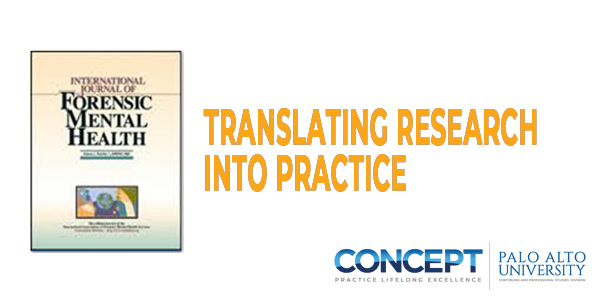Given the differences between sex offender subgroups, it may be important to consider offender types and their unique risk factors when developing sex offender management practices. This is the bottom line of a recently published article in the International Journal of Forensic Mental Health. Below is a summary of the research and findings as well as a translation of this research into practice.
%20Evaluations.jpg?width=120&height=155&name=Multiple%20Feigning%20Strategies%20Used%20in%20Competence%20(CST)%20Evaluations.jpg)
Featured Article | International Journal of Forensic Mental Health | 2017, Vol. 16, No. 1, 58-68
Understanding Sexually Abusive Clergy as a Unique Offender Subgroup: Risk-based Comparisons Across the Course of Offending
Authors
Anthony D. Perillo, John Jay College and the Graduate Center, CUNY
Anniken L. W. Laake and Cynthia Calkins, John Jay College of Criminal Justice
Abstract
The current study compares offending trends of sexually abusive clergy (n = 1,428) to general sex offenders (n = 2,842) on risk measure items coded across the course of offending. Results suggest significant differences on most risk-relevant variables. Clergy were particularly more likely to have male victims, V = .62, 95% CI [.58, .65], and less likely to be married, V = .59, 95% CI [.56, .63], or use force, V = .76, 95% CI [.73, .79]. The magnitude of differences remained when matched on offense factors (e.g., male child acquaintance victims). Findings suggest sexually abusive clergy are a unique subgroup differing from general sex offenders on factors associated with recidivism.
Keywords
sexual abuse, clergy, sex offenders, offense trends
Summary of the Research
“Research examining sexually abusive clergy is relatively sparse, but some characteristics of sexually abusive clergy and their offenses have recently been identified. A study that examined a sample of 4,392 sexually abusive Catholic clergy found this group typically offended in their thirties, committed several types of sexual abuse, offended in private places such as the work place or home, conducted abusive behavior for more than a year, and had male victims aged 11-14. Likewise, in a study comparing clergy and non-clergy samples of individuals accused of child sexual abuse, the clergy group overall had a higher educational level, tended to be older, reported lower sexual drives, and reported fewer victims who again tended to be older and male” (p. 59).
“The distinct age range for victims of sexually abusive clergy initially added fuel to the discussion of additional clinical diagnoses of sexual attraction toward pubescent and post-pubescent minors. Some hypothesize that the late onset age of abusive behavior and the overrepresentation of male victims among sexually abusive clergy are greatly influenced by opportunity, namely the fact that children serving in church are typically male and that unsupervised contact with children often increase over the course of a clergy’s career. The extent to which these factors justify considering sexual abusive clergy as a distinct subgroup of offender is therefore in question” (p. 59).
“The unique religious and situational context of serving within the Church may also contribute to sexually abusive clergy as a unique subgroup. Being sworn to celibacy and having limited exposure to women as seminarians may negatively impact the psychosexual development of Catholic clergy. However, a study comparing cleric and non-cleric individuals accused of sex offenses, found that, when controlling for a number of demographic variables such as educational level, age, and marital status, offending patterns among clerics were similar to those of non-clerics in multiple ways. Overall, the early research on sexual abusive clergy leaves open the question of whether they are a unique subgroup of offenders” (p. 59).
Current Study
“The current study compared offender and offense characteristics of sexually abusive clergy to those of a group of general sex offenders to determine whether sexually abusive clergy appear to be a unique subgroup of offenders. Comparisons were further made between sexually abusive clergy and specific subsets of general sex offenders (those with only child victims, those with child acquaintance victims, and those with male child acquaintance victims) to examine whether differences between sexually abusive clergy and general sex offenders are better explained by considering these clergy as belonging to a specific (but already considered) subgroup of sex offenders” (p. 59-60).
“Data (N = 4,272) originated from two independent datasets, both based on archival data. The first dataset included records from active and former clergy with documented allegations of sexual abuse against children occurring from 1980-2002 (n = 1,428). The second dataset included records of male sex offenders incarcerated for a sexual offense and released from custody from 1996–2007 (n = 2,844). Group comparisons were based on items from the Static-99, Static-99R, and the Minnesota Sex Offender Screening Tool-Revised (MnSOST-R)” (p. 60-61).
Results
“Most likely impacted by the circumstances surrounding clergy life and working within the Catholic Church, the clergy sample exhibited little-to-no variance on several items. For example, no clergy victims were strangers. Other items with minimal variance for clergy include history of non-sexual violence, being younger than age 25 at time of offense, ever being married (or co-habitating with a partner for at least two years), and history of adolescent antisocial behavior. The minimal variance on these items can be attributed to both the circumstances of clergy life and a lack of available records on other items. For the general sample, variance of scores was observed on all risk items” (p. 62).
Overall group comparisons. “Compared to general sex offenders, sexually abusive clergy showed distinct patterns on most risk items measured, including all items on the Static-99/99R. Large effect sizes were revealed for three of the items from these measures: sex offenses, with clergy having significantly more offenses on record than general offenders; having a male victim, with a significantly larger portion of clergy having male victims; and ever being married, with significantly fewer clergy ever being married or living with a lover for at least two years. Another three items were observed to have medium effect sizes: clergy were significantly less likely to have history of non-sexual violence; significantly more likely to have an unrelated victim; and significantly less likely to have a stranger victim” (p. 62).
“For items from the MnSOST-R, clergy abusers presented with significantly different patterns on all but one item; there were no significant differences between clergy abusers and general offenders with regard to the number of different age groups offended against. Large effect sizes were observed for two MnSOST-R items: clergy were significantly less likely to have physically threatened or used physical force against victims, or to have committed multiple types of sexual acts against a single victim. Medium effect sizes were observed for four items: clergy were significantly less likely to have a history of adolescent antisocial behavior, substance abuse, or disciplinary action during an incarceration, and were significantly less likely to have offended against strangers, Finally, although there were only small effect sizes for offender age at first event, clergy were significantly older than general sex offenders at first documented offense, an average of approximately ten years” (p. 62).
“Although the clergy and general samples differed on the presence of most risk items, the overall trends did not appear to push heavily in one direction with regard to higher or lower risk for one group . . . More notable, however, was the split of risk items from different measures as a function of risk direction. Most of the items that differed in a direction of higher risk for clergy originated from the Static-99/99R. In contrast, most the items that differed in a direction of lower risk for clergy originated from the MnSOST-R” (p. 62-63).
Translating Research into Practice
“Results of the current study suggest sexually abusive clergy indeed differ from general sex offenders on offending patterns and personal characteristics included as actuarial sexual risk items . . . Several robust differences identified on the Static-99/99R (e.g., having male victims) appear to be influenced to some degree by contextual factors within the Church. One such difference is the increased number of victims for clergy, which may have been impacted by a lack of supervision for clergy, a lack of reporting of sexual abuse, and Church responses to abuse allegations that often granted continued unsupervised time with children. What remains unclear, however, is the extent that these findings would be different had these clergy abused outside the Church environment. For example, it is not surprising that the majority of victims for sexually abusive clergy are male (whereas most victims for general offenders were female), given that clergy are far more likely to have professional and unsupervised private time with males than females. It is unknown how significantly the rate of male victims would change were these clergy to have offended outside the Church” (p. 65).
“Results of the follow-up analyses suggest that aside from general victim characteristics, sexually abusive clergy are no more similar to different subsets of sex offenders with similar victims than they are to other sex offenders in general. Overall, from the perspective of factors included in actuarial risk assessment, the findings suggest sexually abusive clergy represent a unique subset of sex offenders that have demonstrated different offense patterns over their course of offending. As such, unique or altered considerations may be warranted when understanding clergy sexual abuse” (p. 65).
Other Interesting Tidbits for Researchers and Clinicians
“Although conclusions and recommendations for actuarial risk assessment with sexually abusive clergy cannot be drawn from the current study, the fact that the current analyses included factors used in risk assessment with general sex offenders lends itself to preliminary theorizing on the prospects of extending current actuarial risk instruments with sexually abusive clergy. Relative to sex offenders in general, sexually abusive clergy present with different patterns on variables included on currently used risk measures. Because these offender and offense variables contribute to overall scores on risk measures, the combination of these differences may create different sum score distributions and, in turn, markedly different pictures of risk for sexually abusive clergy” (p. 65-66).
“For example, stark differences such as sexually abusive clergy having a higher rate of offending against unrelated victims, having more victims, and having never been married would seemingly increase risk for future offending. In contrast, differences such as sexually abusive clergy having lower rates of using force, lower rates of non-sexual violence, and lower rates of substance abuse would seemingly decrease risk for future offending. The lack of variance for sexually abusive clergy on these variables suggests that sexually abusive clergy would likely be assessed with poor discrimination, hindering efforts to distinguish higher-risk clergy from lower-risk clergy” (p. 66).
“Changes from the Static-99 to the Static-99R may greatly impact the instrument’s utility with sexually abusive clergy. The revised scoring of offender age on the Static-99R, which lowered risk scores for older offenders, would be expected to both lower mean risk scores and increase the variance across sexually abusive clergy. Such changes may increase the instrument’s utility with this group, though the Static-99R’s validity with clergy is currently unknown. In addition, differences in the factors assessed on the Static-99/99R and the MnSOST-R may impact their use with clergy. The MnSOST-R includes more items related to general antisociality than the Static-99/99R, which appears to focus primarily on sex-related items. Given the minimal presence of (non-sexual) antisocial behavior among clergy in the current study and research suggesting sexual and social development issues among sexually abusive clergy, sexual and social deviancy would likely be more relevant to assessing sexual risk among clergy than general antisociality. The Static-99/ 99R, therefore, may ultimately be preferred over the MnSOST-R when assessing sexually abusive clergy” (p. 66).
Join the Discussion
As always, please join the discussion below if you have thoughts or comments to add!























